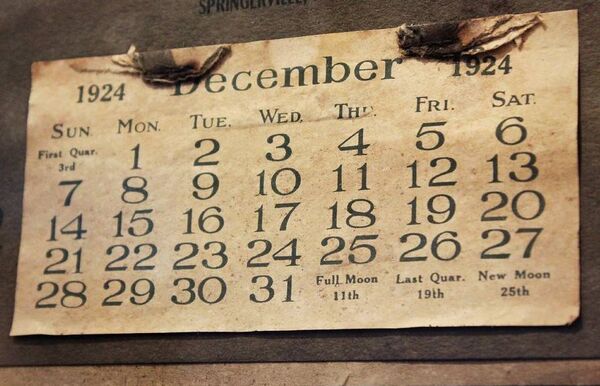December: Dark for some, hopeful for others

Since prehistory, the winter solstice has been a significant time of year in many cultures and has been marked by festivals and rituals.
December is not likely to top the polls when it comes to people choosing their favourite month. Not even the inclusion of Christmas would get it elected. Most people see it as the month when everything dies and the brighter days of spring are still a few months away.
December is the twelfth month of the year and in the northern hemisphere usually considered the first month of winter so, for those reading this in Australia, I suggest you now turn off your lights and sit beside your fridge with its door ajar.
Like many things that were named a long time ago, with the passage of time the name becomes inaccurate. December got its name from the Latin word decem (meaning ten) because it was originally the tenth month of the year in the calendar of Romulus (c. 750 BC), which began with March. The winter days following December were not included as part of any month. Later, the months of January and February were created out of the intervening period between December and March and added to the beginning of the calendar.
The winter solstice occurs during the Northern Hemisphere's winter. This is also known as the December solstice and usually occurs on 21 or 22 December. Although the winter solstice itself lasts only a moment, the term also refers to the day on which it occurs. The term midwinter is also synonymous with the winter solstice, although it carries other meanings as well and traditionally is seen as the middle of winter. Locally, in our Ox Mountain region, this day was simply known as, The Shortest Day.
Since prehistory, the winter solstice has been a significant time of year in many cultures and has been marked by festivals and rituals. It marked the symbolic death and rebirth of the Sun. Some ancient monuments such as Newgrange and Stonehenge are aligned with the sunrise or sunset on the winter solstice. I am quite sure that the first man who was aware of the importance of the sun to the planet, cut a lonely figure as he saw the sun go down on his world at the end of the year. It is quite likely that he felt the game would surely be up if the tired sun failed to rise again. And so, the rituals to encourage rebirth and resurrection to rise again began.
Two rituals of early man, once he got the planet working in his favour, was to celebrate his achievements and pray for his future. He had a good year and survived so he celebrated and gave thanks but now he was facing a new year when he was anxious that The Powers That Be would stay onside. These were understandable thoughts from a human point of view but held little sway over the power of the sun. The sun was a very real god at that time and such rituals made man feel empowered and positive about his future. Such beliefs and rituals represented the earliest form of religion.
Yule is widely understood to be a 12-day celebration that begins on the eve of the winter solstice and ends at New Year. This celebration was so important to people in ancient times that Christians later converted it into the 12 Days of Christmas.
During this period, the yule log would be burned each day and would continue to burn as families moved the log further into the fire. The yule log would begin burning on the shortest day and continue burning until New Year. A small museum in the UK, St Noets Museum, expands on the Yule tradition and its origins.
When I was a child, I knew an old bachelor who lived in my neighbourhood. His house, more like a cabin, was usually in a constant state of untidiness. He was not a man for the bog and so his fire fuel was expedient; whatever he could find. He would often walk back to his cabin dragging a long branch of a tree behind him. He would simply put one end of the branch in his fire and the rest would extend through his kitchen. Over the course of a few days, the timber would eventually be burned up. Amusingly, this action didn’t just take place over the 12 days of Christmas, but on the other 353 days of the year as well.

My own thoughts on December take me back to childhood with the memories of dark and damp days, long nights and the anticipation of Christmas breaking the monotony. Life on a small farm was greatly impacted under such conditions. Essential chores got done during the few fleeting hours of daylight but much of the other work was completed in the dark. I have no experience of December before rural electrification, but, back then, it must have been a much darker and colder month.
I can still see my father heading out on a stormy evening with a back-load of hay on his back to feed a bunch of outlying cattle on the sheltered side of a whitethorn hedge. It was almost dark as he returned to the hayshed. There, he still had to cut enough hay for 12 cows and after that, he carried it to them, armful by armful, into the cowhouse.
It was never-ending work, morning and evening during these short days of winter. He never seemed to complain about the difficult conditions that this time of year often presented. He seemed to see the whole thing as a kind of novelty; a challenge that December put before him. Like his ancient ancestors, he probably saw the whole thing as a kind of ritual; a prayer of thanks for the summer that provided the hay and a feeling that a new crop of calves wasn’t far away.
My other thoughts about December engender a warm glow. The long nights are not the worst and in general, it is a more relaxed time of year. There is the prospect of frost and snow and in terms of school, it is a short month. The early weeks can be tedious but Christmas is just around the corner. Apart altogether from the religious celebrations associated with December – which mean so much to so many - its position on the calendar of the Northern Hemisphere is perfectly placed. December accommodates the ultimate end-of-year celebration and while our beliefs have changed over the millennia, ritual is still an essential part of our survival, reminding us of the need to offer thanks and express hope for the future.






